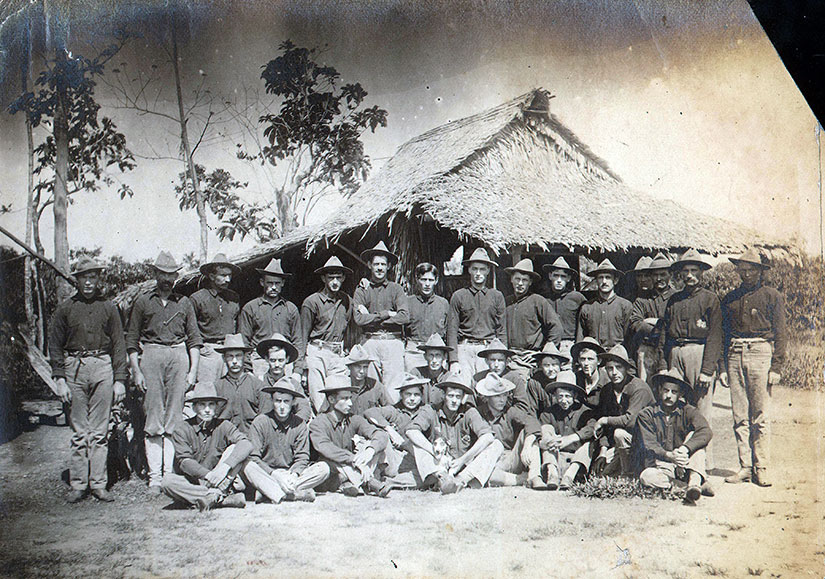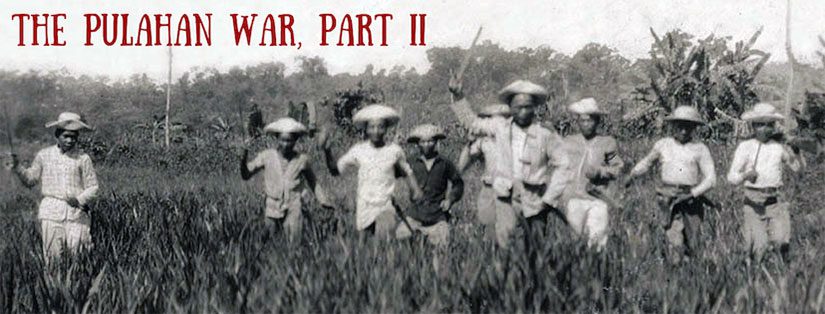[This is part two of a three-part series on the Pulahan War. Find the links for parts one or three here.]
Fanatics are not easy to fight. An American officer of the period, Victor Hurley, wrote on page 60 of Jungle Patrol:
These red-garbed mountaineers, with white flowing capes and crescent blades, were contributory to one of the most ferocious eras of guerrilla warfare that our arms were to experience. Not even the Indian campaigns of the old West, fought in open country, could compare with the rushing, jungle-shielded tactics of the Pulahans.”
Russell Roth described an attack on page 99 in Muddy Glory:
Brandishing their talibongs (two-foot-long, razor-keen bolos), which could behead a man at a stroke, and assured of ‘invisibility’ by their anting-antings, they suddenly appeared in the valleys, red garb bedecked with crosses, charging en masse, shouting ‘Tad-tad!’ [“Chop-chop!”] as, in blade-spinning wave after wave, they attempted to overrun whatever stood in their path.
If this does not sound fierce enough, some Pulahans carried a blade in each hand: “two revolving disks of scintillating steel,” according to Russell Roth’s article in volume 2, 1978 issue, of the Bulletin of the American Historical Collection. “One veteran witnessed a Pulahan split a soldier from his shoulder to his buttocks with a single bolo stroke” (Linn, 52). In fact, the Pulahans were better off with knives than rifles, partly because their captured Springfields were single-shot guns. (In this kind of war, no matter which side, by the time you reloaded, you were already dead.) Moreover, the Pulahans did not know how to use gun sights, and they almost always aimed high (Hurley, 93). On the other hand, “When the Pulahans got to close quarters with their great knives, massacre was the result” (Hurley, 62).
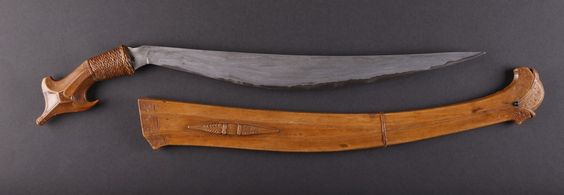
There were about 3,000 of these bolomen, and about 10,000 more men who provided them with intelligence and material support (Borrinaga, G.E.R, “Pulahan Movement in Samar,” 261). In January 1905, just before the worst of the fighting, there were less than 2000 armed Insular forces: 900 Constables (Filipino police under the civilian government), 600 Scouts (Filipino soldiers under US Army command), and about 350 regular American soldiers in the 14th Infantry (Linn, 55) on Samar. The Constables and Scouts had inferior rifles, the aforementioned Springfields. But even a Krag’s five-shot magazine was not a great choice in close-quarter fighting: “since not all men were issued bayonets, they found themselves using the rifle as a baseball bat in hand-to-hand combat” (Borrinaga, G.E.R., “Pulahan Movement in Leyte,” 232).
The Pulahans not only terrorized the American forces, they terrorized lowland villagers, as well. Those who cooperated with the Insular officials were meted out punishments with special malice. In one town, they wrapped up the barrio lieutenant’s head in a kerosene-soaked American flag and set it on fire. The Pulahan leader said in front of the crowd: “Call upon the flag you have adopted to protect you now” (Hurley, 62). Then they burned down the village and carried off 50 of its people.
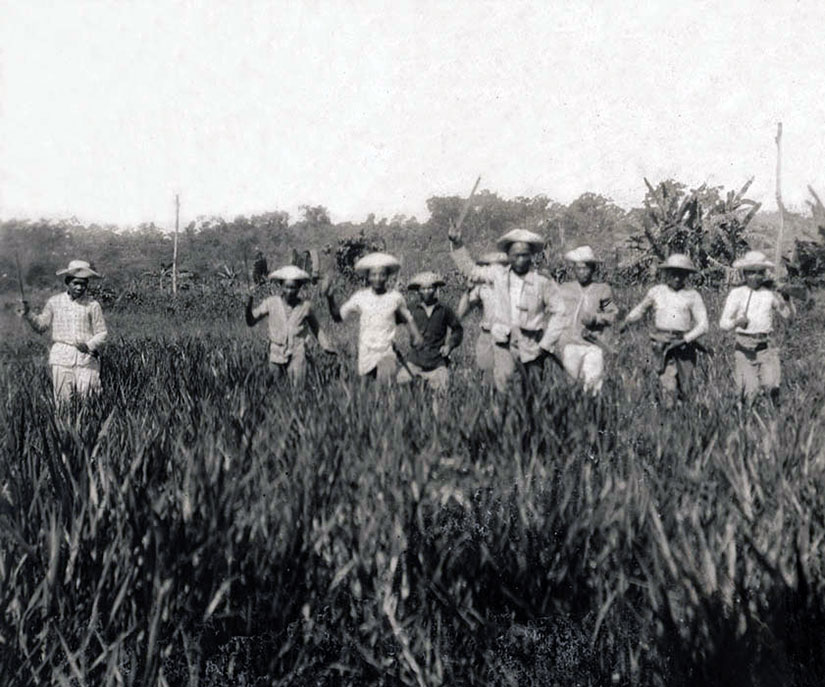
Every time the Americans thought they had a handle on the situation, the Pulahans came back like the walking dead. Individually or as a group, they were persistent. Lieutenant Norman Cook described: “The one who stabbed Lt. Gustin, although shot 5 times with Springfields and with one entire charge of buckshot in him was still trying to crawl up on Lt. Gustin when [Gustin] reloaded his shotgun and blew out his brains” (quoted in Linn, 52-53). Even Pulahans who had surrendered to the Americans, been released, and remained at peace for a year could suddenly concentrate and reorganize to pillage a rival town (Linn, 49). The Pulahans even attacked at their own surrender ceremony, as described by Philippine-American War historian Brian McAllister Linn on page 61 of “The Pulahan Campaign: A Study in US Pacification“:
The sectarians filed in, looked at the crowds and then suddenly attacked, killing 22 constables, capturing several rifles, and disappeared into the jungle. [Governor] Curry, who himself had narrowly escaped being boloed, notified military commanders that “in your operations outside the towns and barrios you may kill anyone you have reason to [believe] a Pulahan…”
Why was Governor Curry in an isolated village with only a Constabulary honor guard to protect him, anyway? Was he stupid, or just spectacularly optimistic? The answer is part of a larger reason why American rule on Samar was so vulnerable. Curry had wanted his civil government, made up of civilian bureaucrats, to get the sole credit for the surrender. As such, he did not invite the Scouts or US Army to the party.
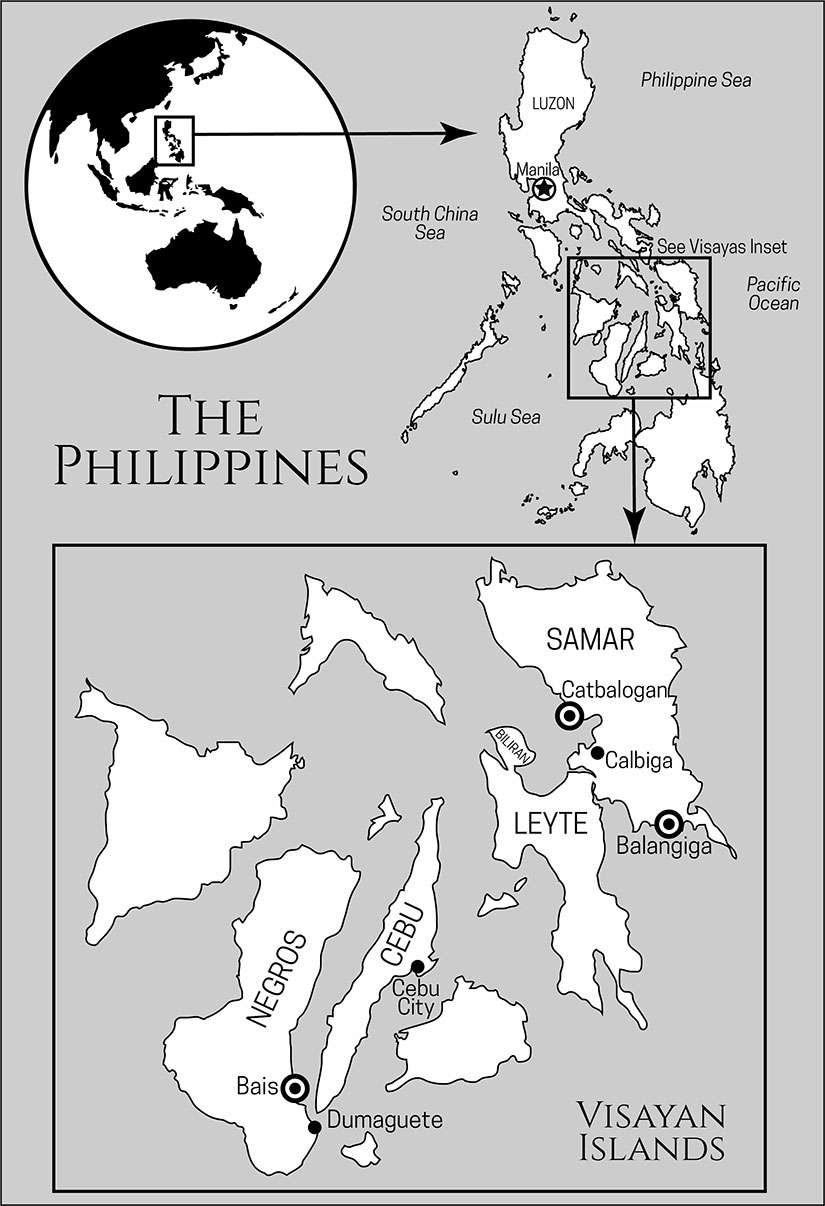
This rivalry between civil and military authorities—both American—was one reason why the initial response to the Pulahans was weak. The civil government under William Howard Taft and his subordinates on Samar and Leyte were “determined to show they governed with Filipino support, not armed force” (Linn, 53). General Henry T. Allen, commander of the Philippine Constabulary, should have turned over the Pulahan problem to the Scouts and Army earlier. The ill-equipped and understaffed Constabulary was built to keep law and order, not fight a war. But instead, Allen gave sanguine reports to his superiors in Manila that his men were getting the job done. In reality, “[b]y the end of 1904, many of the colonial forces were demoralized, much of the north and east of Samar was under Pulahan control, and the island was verging on anarchy” (Linn, 55).
And then the U.S. Army showed up…again. Would they make Samar a “howling wilderness”…again? Read part three on the Pulahan War in the next post.
